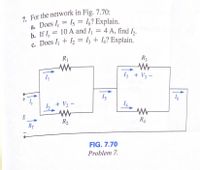
Concept explainers
1. For the network in Fig. 7.70:
a. Does Is = I5 = I6? Explain.
b. If Is = 10 A and I1 = 4 A, find I2.
c. Does I1 + I2 = I3 + I4? Explain.
d. If V2 = 8 V and E = 14 V, find V3.
e. If R1 = 4 Ω, R2 = 2 Ω, R3 = 4 Ω, and R4 = 6 Ω, what is RT?
f. If all the resistors of the configuration are 20 Ω, what is the source current if the applied voltage is 20 V?
g. Using the values of part (f), find the power delivered by the battery and the power absorbed by the total resistance RT.


Step by stepSolved in 2 steps with 1 images

d. If V2 = 8 V and E = 14 V, find V3.
e. If R1 = 4 Ω, R2 = 2 Ω, R3 = 4 Ω, and R4 = 6 Ω, what is RT?
f. If all the resistors of the configuration are 20 Ω, what is the source current if the applied voltage is 20 V?
g. Using the values of part (f), find the power delivered by the battery and the power absorbed by the total resistance RT.
d. If V2 = 8 V and E = 14 V, find V3.
e. If R1 = 4 Ω, R2 = 2 Ω, R3 = 4 Ω, and R4 = 6 Ω, what is RT?
f. If all the resistors of the configuration are 20 Ω, what is the source current if the applied voltage is 20 V?
g. Using the values of part (f), find the power delivered by the battery and the power absorbed by the total resistance RT.
- PROBLEM 4: For the following circuit, determine the values that will be displayed on the DMMs. Assume all elements are ideal and that Is = 44 mA, R₁ = 100, R2 = 2002, R3 = 30 S2, R4 = 40 2, R5 = 50 S2, R6 = 60 2, R7: 70 2 and, Rs = 80 . 80 . You must briefly explain your calculations - a relevant sketch with the meters replaced with their ideal models will be necessary! = R₂ R₁₁ www R3 www Is R8 www Meter 2 R4 www A com e R7 ? R5 www R6 Meter 1 com V ?arrow_forwardOk I’m not sure right I need to option true or false explainarrow_forwardA battery is comprised of 6 cells connected in parallel, each cell has an EMF with 1.5V and an internal resistance of 0.50 ohm. There is a 4.6 ohm load connected to the terminals. Solve for VLoad.arrow_forward
- A moving coil ammeter gives a full scale deflection for a current i = 300 mA and its coil has a resistance RC = 1Ω. To use this ammeter as a voltmeter that measures 9V at full scale deflection a multiplier resistance, RM, is added in series with the coil. What is the value of the multiplier resistance? Select one: a. 31 Ω b. 32 Ω c. 30 Ω d. 29 Ωarrow_forward7.1arrow_forwardRin Fig. 7 -M R₂ +VDD RD VID M₁ Vo R₂arrow_forward
 Introductory Circuit Analysis (13th Edition)Electrical EngineeringISBN:9780133923605Author:Robert L. BoylestadPublisher:PEARSON
Introductory Circuit Analysis (13th Edition)Electrical EngineeringISBN:9780133923605Author:Robert L. BoylestadPublisher:PEARSON Delmar's Standard Textbook Of ElectricityElectrical EngineeringISBN:9781337900348Author:Stephen L. HermanPublisher:Cengage Learning
Delmar's Standard Textbook Of ElectricityElectrical EngineeringISBN:9781337900348Author:Stephen L. HermanPublisher:Cengage Learning Programmable Logic ControllersElectrical EngineeringISBN:9780073373843Author:Frank D. PetruzellaPublisher:McGraw-Hill Education
Programmable Logic ControllersElectrical EngineeringISBN:9780073373843Author:Frank D. PetruzellaPublisher:McGraw-Hill Education Fundamentals of Electric CircuitsElectrical EngineeringISBN:9780078028229Author:Charles K Alexander, Matthew SadikuPublisher:McGraw-Hill Education
Fundamentals of Electric CircuitsElectrical EngineeringISBN:9780078028229Author:Charles K Alexander, Matthew SadikuPublisher:McGraw-Hill Education Electric Circuits. (11th Edition)Electrical EngineeringISBN:9780134746968Author:James W. Nilsson, Susan RiedelPublisher:PEARSON
Electric Circuits. (11th Edition)Electrical EngineeringISBN:9780134746968Author:James W. Nilsson, Susan RiedelPublisher:PEARSON Engineering ElectromagneticsElectrical EngineeringISBN:9780078028151Author:Hayt, William H. (william Hart), Jr, BUCK, John A.Publisher:Mcgraw-hill Education,
Engineering ElectromagneticsElectrical EngineeringISBN:9780078028151Author:Hayt, William H. (william Hart), Jr, BUCK, John A.Publisher:Mcgraw-hill Education,





